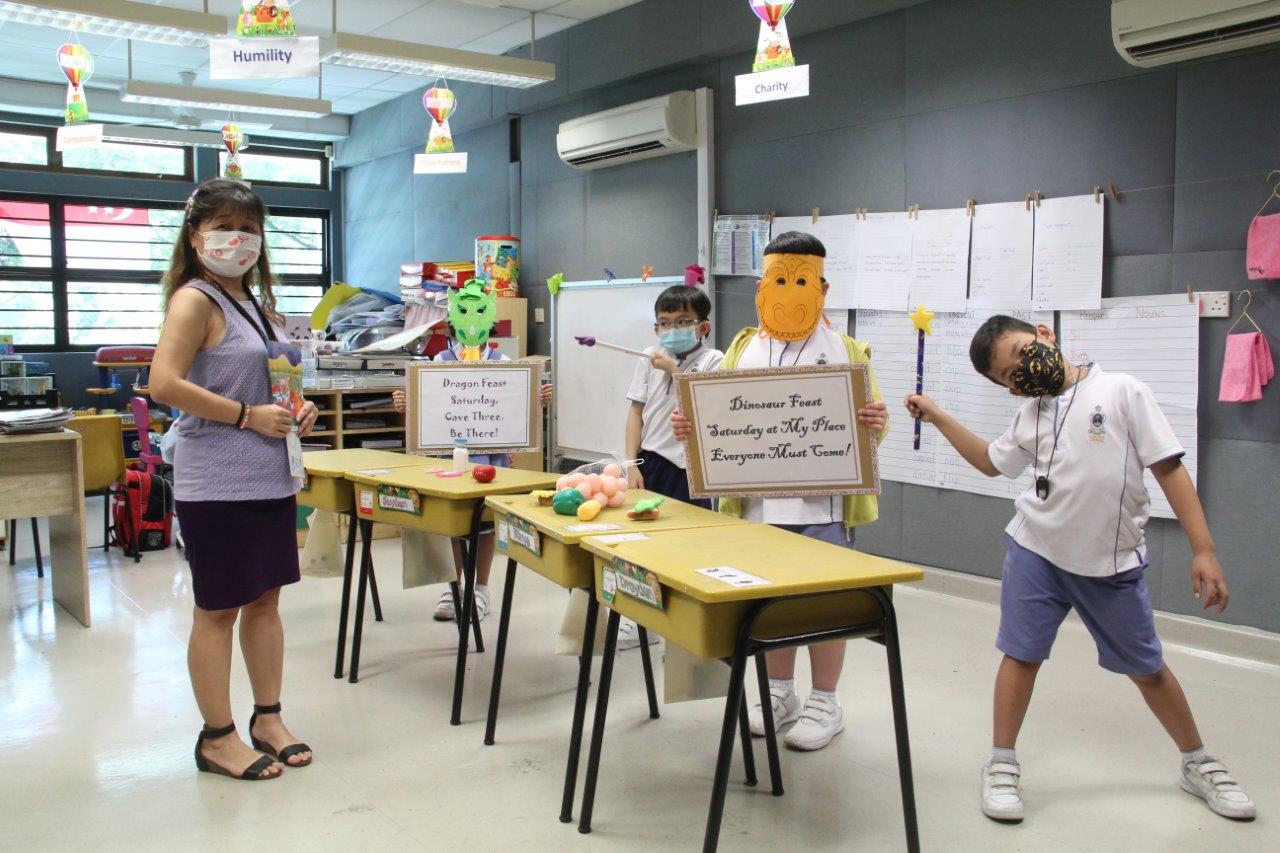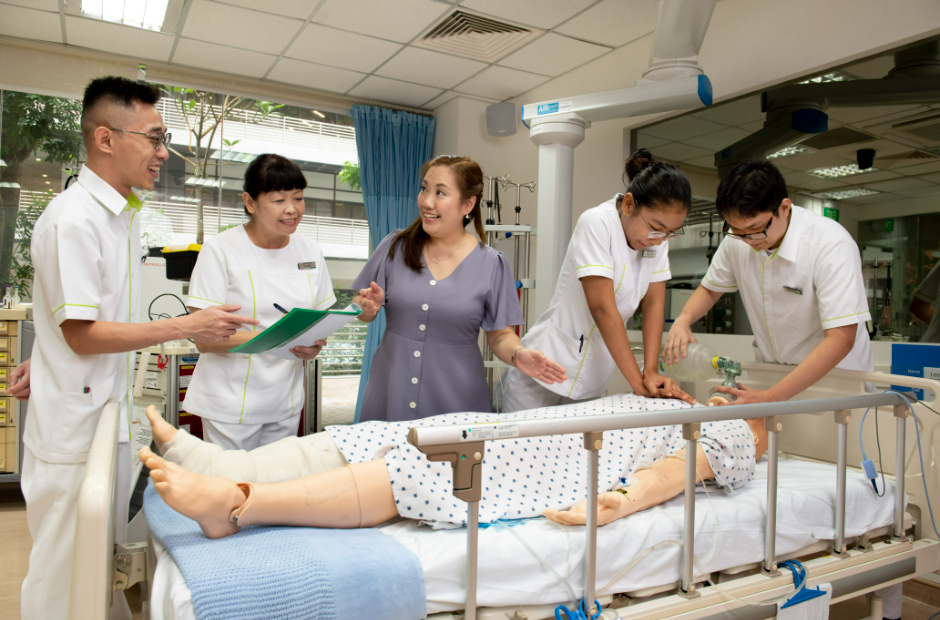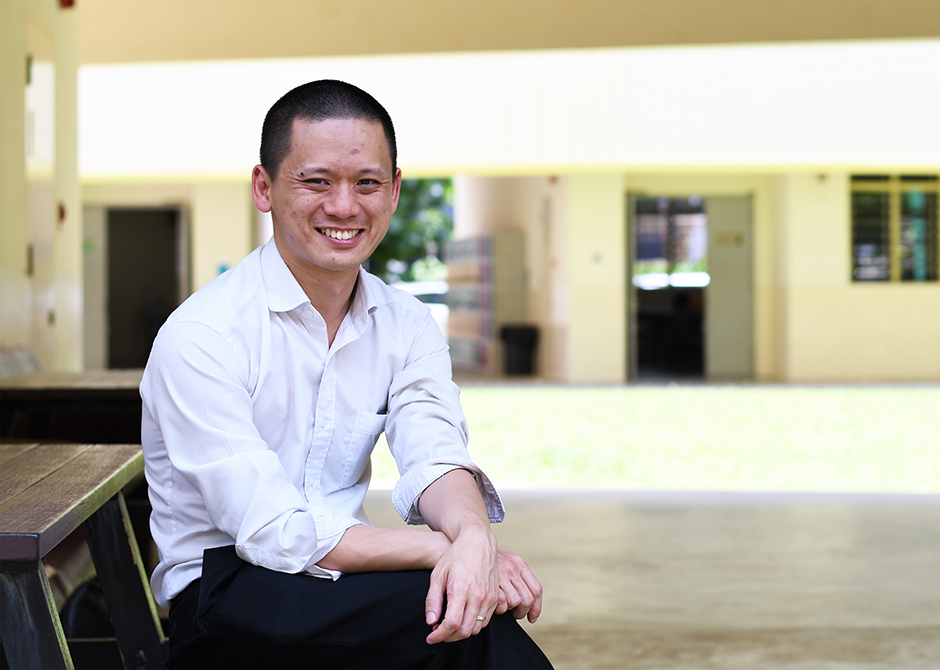Role-playing their way to better speech
Alice Tay Bee Poh, better known to her students as Mrs Ng, joined Canossian School in 2010 as a Teacher, the same year her daughter was enrolled in the school. Her daughter has hearing loss. “I know the struggles my daughter has, and I too, hope to help other children like her,” says Mrs Ng, who is also a source of support for her students’ parents.
In class, Mrs Ng finds role-playing to work especially well for teaching students with hearing loss, particularly to hone their communication skills and build their confidence in expressing themselves verbally in front of an audience. It’s also a fun way for them to expand their vocabulary and improve their sentence structures. She assigns roles according to her students’ abilities and interests, and works with them individually to practise their lines and expressions, before they come together as a class to act out the story.
Planting seeds of joy and collaboration

Photo caption: Mrs Audrey Chin with a ‘Fun Fernvale Farmer’ measuring the growth of his beansprouts. (Photo taken in accordance with COVID-19 Safe Management Measures.)
At Fernvale Gardens School, beansprouts are a teaching tool. This initiative, called the Fun Fernvale Farmers, is a Project-Based Learning (PBL) farming programme developed by Mrs Audrey Chin, Year Head and Head of Department (Math and Science), and her team.
Students get a taste of what urban farming is like by growing their own beansprouts. By observing and recording the growth of the plants, they pick up skills such as taking measurements and collecting data. As they are tasked to work together to care for the plants, they learn to communicate and collaborate with one another.
Mrs Chin who has been a SPED teacher for 27 years, wanted to try this PBL approach with the students, where learning is integrated and experiential and her students, who have Autism Spectrum Disorder (ASD), are able to relate what they learn to real-world scenarios. To get her colleagues on board this idea, Mrs Chin also developed tutorials and visual aids that teachers could use to guide their students in this process.
Seeing how her students have flourished in their farming efforts, Mrs Chin says, “Given the right time, strategies and necessary support, our student will be able to make progress in their learning.” At the end of this project, the students get to enjoy the fruits of their labour – they harvest and learn to cook them during their domestic science lesson!
A strikingly good idea for badminton

Photo caption: Ms Rachel Yu with a student practising badminton strokes using equipment she designed. It produces clanging sounds when hit, to give audio feedback. (Photo taken in accordance with COVID-19 Safe Management Measures)
At the sports hall in Grace Orchard School, you can find empty plastic bottles hanging from a line tied across two poles for a badminton lesson. Ms Rachel Yu Rui Qi, Subject Head of the school’s Physical Education, came up with the idea behind the apparatus to help her students learn how to play badminton.
Specifically, these plastic bottles help them when practising their swings and strokes, producing a clanging sound when struck – the audio and haptic feedback helps them calibrate their actions. Her students, who are diagnosed with mild intellectual disability and/or autism spectrum disorder, also benefit from visual and verbal cues to better comprehend their tasks.
For those who struggle to position their grip on the badminton racket correctly, Ms Yu sticks masking tape on the racquet handle to form the letter ‘V’ and draws circles to indicate where and how they should place their fingers.
Ms Yu, a SPED teacher for nine years, believes that her students can learn as long as they are given the right support and see the importance of what they are doing. She constantly reviews her lessons and reflects on what she can do to help her students learn better. “What motivates me is seeing the sparkle in my students’ eyes when they finally get the task, and witnessing their growth throughout the years.
Helping the non-verbal to find their voice

Photo caption: Ms Eunice Choo (left) guiding Khodijah (right) to feel the texture of a straw house she created, during a multisensory storytelling experience of the Three Little Pigs. (Photo taken before COVID-19.)
“There are many things the child wants to say, but how do you give a voice to someone who is non-verbal?” Senior Teacher Ms Eunice Choo asked herself one day.
Over the past five years at Rainbow Centre Margaret Drive School, Ms Choo has been working with students with high support needs. Siti Nur Khodijah Binte Mohammad Badrussalam, for instance, has visual impairment, a limited range of movement and is non-verbal. Working with Khodijah, Ms Choo realised she has difficulties accessing typical lesson materials, which require visual and auditory competencies.
Her solution? For a literacy lesson, instead of just reading the Three Little Pigs book aloud to her students, Ms Choo put together a multisensory storytelling experience. She created ‘straw’, ‘stick’ and ‘brick’ houses using different materials so her students could touch and feel the textures of the different houses. She also involved Khodijah by getting her to “deliver” the characters’ lines using a voice output device, which stores the pre-recorded lines.
During a storytelling session, Khodijah’s eyes were wide open, clearly delighted by the experience. She also moved her hands excitedly to press the voice activation button at all the right times. Khodijah’s reaction was the best possible affirmation for Ms Choo. “What I aspire to do as a Special Education teacher is to leave no one behind, and give everyone a voice. The challenge to find meaning in life, both theirs and mine, motivates me as a SPED teacher,” she says.
Learning through all kinds of movements

Photo caption: Ms Yuhanis Kadis teaching her students to handle their digital devices independently. (Photo taken in accordance with COVID-19 Safe Management Measures.)
Ms Yuhanis Kadis’s classroom at St Andrew’s Autism School is always buzzing with activity. Her students hardly get to sit down – which is perfect for her students who have ASD and enjoy movement. Ms Hanis, who has been teaching at the school for five years, designs activities that cater to different learning needs, from kinesthetic to tactile.
Nothing beats seeing her students eager to learn. “It brings me joy to see my students have fun during the learning process. That itself is motivation to keep doing what I do,” she says.






.jpg)